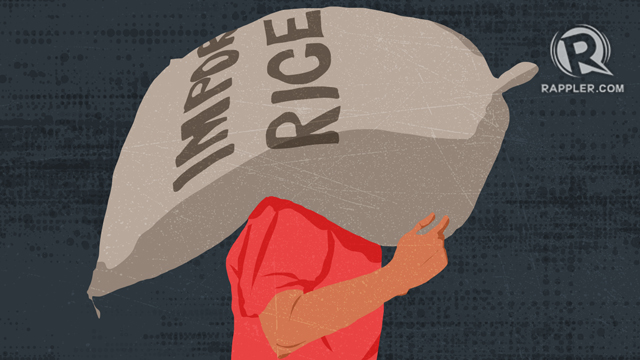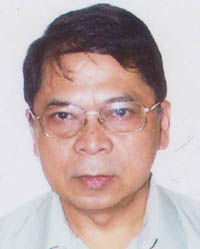

“We’re a blessed nation because we can grow our own food and, therefore, we’re secure. A nation that can feed its people is a nation more secure.”
President George Bush said this on the occasion of the signing of the US Farms Bill in 2002, which is renewed every 5 years and which allocates massive subsidy to American agriculture.
With the proposed lifting of the quantitative restrictions on rice, the private sector shall be able to import rice – freely so long as it pays for the tariffs set by the government. No more importation monopoly of the National Food Authority (NFA). No more rice inflation? No more rice pila (queue).
Price stability is the main argument of the proponents of rice importation liberalization. To them, food security is simply the ability of a country to buy agricultural products wherever they are produced, cheaply. This is the theory of the agricultural trade liberalizers. This is the reason the country tariffied agriculture in 1995 (with the exception of sugar and rice), after the Senate ratified Philippine membership in the World Trade Organization (WTO).
The proponents of agricultural trade liberalization embellished the food security argument further by adding that small farmers who cannot compete with cheap producers in other countries need not worry. They can shift to the production of higher-value agricultural products. Accordingly, Philippine agriculture would be a runaway winner under agricultural trade liberalization. They even came up in 1994, at the height of the Senate debates on WTO membership, with the following macroeconomic forecasts: agricultural gross value added of P60 billion a year, agricultural net export earnings of P3.2 billion a year, and 500,000 new jobs in the agri sector every year.
And yet, Philippine agricultural performance from 1995 to the present has been dismal, if not catastrophic – widening net agricultural trade deficits, share of the agricultural sector in the GDP shrinking to less than 10%, deepening massive poverty in the countryside, and, food inflation, averaging close to 5% a year from 1995 to 2017. Thus, with rice tariffication, a number of farmer and civil society organizations (CSOs) such as Patamaba, Integrated Rural Development Foundation, and Freedom from Debt Coalition are raising critical issues which policy makers are still unable to answer.
First, with tariffication, is the government surrendering the entire rice industry business to the private rice traders,who have a leech-like hold on palay trading, rice storage, and rice distribution? Numerous congressional hearings, from the time of President Corazon Aquino up to the present, have come up with ugly findings on the cartel-like behavior of the traders, including cases of smuggling and collusion with corrupt NFA officials on the hoarding and mislabeling of rice. With the tariffication and the further downsizing, if not abolition, of the NFA, these traders shall now have the whole business field to themselves – from palay procurement at home to rice importation, from milling to storage, and from wholesale to retail distribution. They can dictate the farmgate prices that palay farmers would get and the prices for various rice varieties that consumers are willing to buy. How can the government then level the playing field? Who will prevent the rice importers-traders from re-milling cheap imported rice and mixing this with quality rice produced in the Philippines and selling this as “regular milled rice”?
Second, what happens to the goal of rice self-sufficiency? With the influx of cheap imported rice, how can the marginal rice farmers compete? Some of the answers to competitiveness are well-known: better seed varieties, cheap and efficient irrigation, land mechanization, grain dryers, good transport facilities from the farms, and quality rice mills. These have been identified and discussed in past studies. These have been the object of the Agriculture and Food Modernization Act (AFMA) and the Agricultural Competitiveness Enhancement Act (ACEF). And yet, both the billion-peso AFMA and ACEF programs have failed to deliver the promised modernization and prosperity for the farmers. The culprits: the big C (corruption) and the lack of strong visionary leadership in the agricultural sector. Now what is the assurance that the so-called tariff revenues to be set aside for the local rice farming sector shall be able to transform the sector?
Most likely, the land areas devoted to rice farming will continue to shrink. The rice industry in Central Luzon and Calabarzon has been disappearing since the 1980s due to urbanization and industrial development. In a study by Elvira Manalad of Paragos-Philippines, huge swathes of rice lands all over the country are also disappearing because of the widespread “conversion” of lands supposedly covered by agrarian reform and the unchecked “land banking” operations of the big realty companies and housing/village/resort developers. The rainfed rice lands are the most vulnerable to the agents of these companies and developers. Their job is made easier by the absence of a national land use law and the weak monitoring by the Department of Agrarian Reform of the land conversions.
So one of the biggest concerns of farm unions and CSOs is the waning capacity of the government, in a liberalized and deregulated economy, to pursue food security and agricultural sovereignty. Like in the United States and other countries, these unions and CSOs define food security as the capacity of the nation to grow its own food and feed its own people. Food secure means that whatever the volatility in agricultural commodities in the global market there are, the country will be able to survive because domestic production is stable and sufficient. Of course, food security does not mean stopping all agricultural imports. The point is that the Philippines, given its land resources and know-how, should be able to produce in sufficient quantity its basic food requirements.
In the case of rice, the goal of self-sufficiency remains an important one because rice is one of the thinly-traded commodities in the world market. Thus, if a rice shortage occurs in the two major sources of imported rice, Thailand and Vietnam, the Philippines is likely to have a political and economic problem that would be too hot to handle. – Rappler.com
Dr Rene E. Ofreneo is a professor emeritus of the University of the Philippines. He is the president of the Integrated Rural Development Foundation (IRDF), a national non-governmental organization that advocates and promotes people-centered sustainable development. He served as Department of Labor and Employment undersecretary for labor relations from 1997 to 1998, and as executive director of the Fair Trade Alliance, a unique industry-labor-CSO multisectoral coalition and social partnership initiative in the Philippines. He is also a founding trustee of the Philippine Employer-Labor Social Partnership and of the Climate Change Congress of the Philippines.